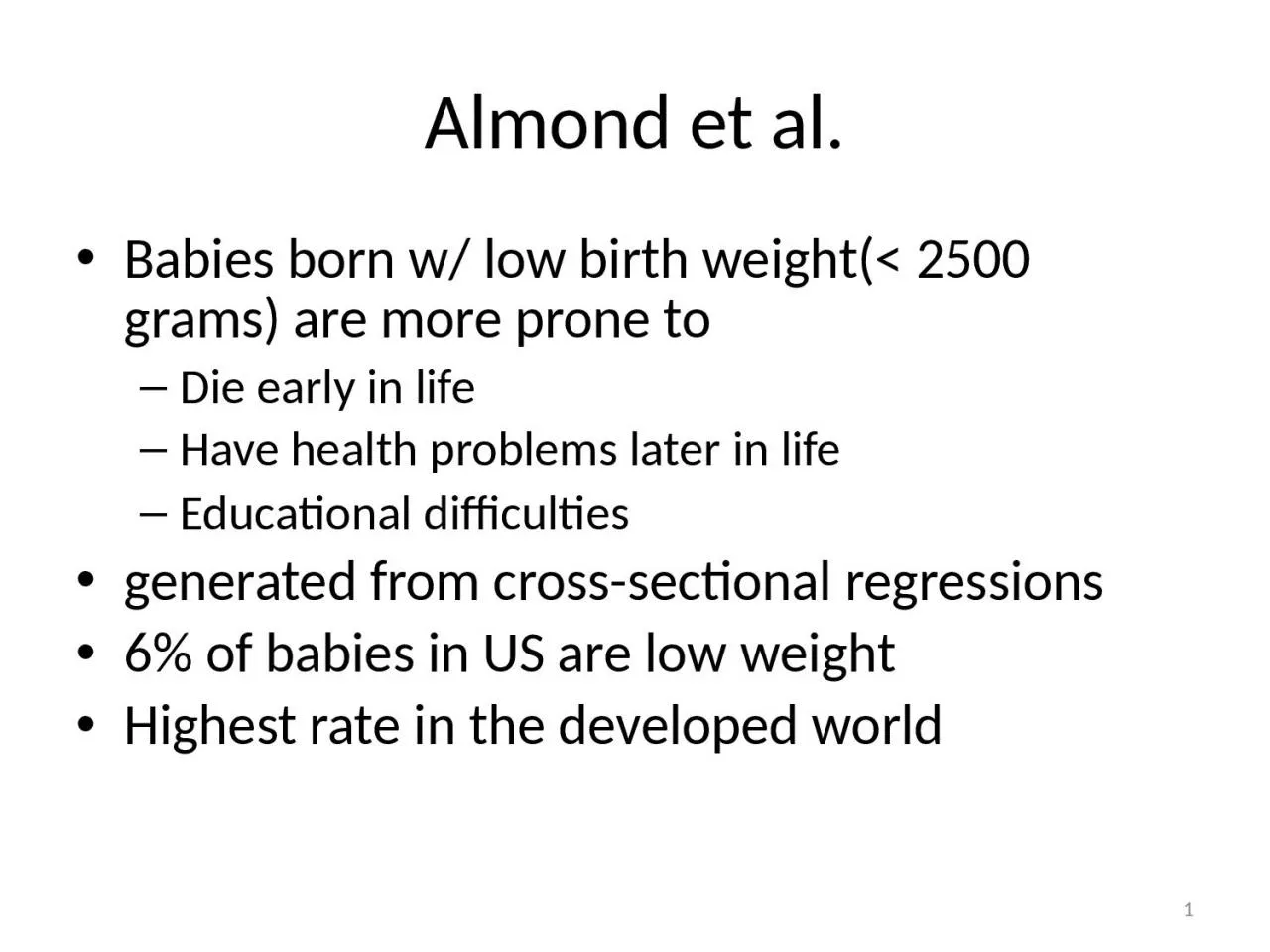

Die early in life Have health problems later in life Educational difficulties generated from crosssectional regressions 6 of babies in US are low weight Highest rate in the developed world 2 ID: 918687
Download Presentation The PPT/PDF document "1 Almond et al. Babies born w/ low birth..." is the property of its rightful owner. Permission is granted to download and print the materials on this web site for personal, non-commercial use only, and to display it on your personal computer provided you do not modify the materials and that you retain all copyright notices contained in the materials. By downloading content from our website, you accept the terms of this agreement.
Slide1
1
Almond et al.
Babies born w/ low birth weight(< 2500 grams) are more prone to
Die early in life
Have health problems later in life
Educational difficulties
generated from cross-sectional regressions
6% of babies in US are low weight
Highest rate in the developed world
Slide22
Let Y
it
be outcome for baby t from mother I
e.g., mortality
Y
it
=
α
+ bw
it
β
+ X
i
γ
+
α
i
+
ε
it
bw is birth weight (grams)
X
i
observed characteristics of moms
α
i
unobserved characteristics of moms
Slide33
Terms
Neonatal mortality, dies in first 28 days
Infant mortality, died in first year
Slide44
Many observed factors that might explain health (Y) of an infant
Prenatal care, substance abuse, smoking, weight gain (of lack of it)
Some unobserved as well
Quality of diet, exercise, generic predisposition
α
i
not included in model
Slide55
Cross sectional model is of the form
Y
it
=
α
+ bw
it
β
+ X
i
γ
+ u
it
where u
it
=
α
i
+
ε
it
Cov(bw
it
,u
it
) < 0
Same factors that lead to poor health lead to a marker of poor health (birth weight)
Slide66
Solution: Twins
Possess same mother, same environmental
characteristics, same pregnancy
Y
i1
=
α
+ bw
i1
β
+ X
i
γ
+
α
i
+
ε
i1
Y
i2
=
α
+ bw
i2
β
+ X
i
γ
+
α
i
+
ε
i2
Δ
Y = Y
i2
-Y
i1
= (bw
i2
-bw
i1
)
β
+ (
ε
i2
-
ε
i1
)
Slide77
Questions to consider?
What are the conditions under which this will generate unbiased estimate of
β
?
What impact (treatment effect) does the model identify?
Slide88
Slide99
Slide1010
Large change
In R2
Big Drop in
Coefficient on
Birth weight
Slide1111
Teenage pregnancy
40% of teen women become pregnant before the age of 20
25% will be a mother by age 20
Most of these pregnancies end in a live birth
About 4 million children born each year, 1/8 are to teen mothers
8% of teen women, aged 15-19 give birth n a given year
Slide1212
Teen birth rates have changed considerably over time
Most of these births are out of wedlock
Rates differ considerably across race
Slide1313
Slide1414
Slide1515
Slide1616
Slide1717
Outcomes of teen mothers
Teen mothers are
Twice as likely to not complete high school
90% less likely to attend college
At age 28 – teen mothers
50% more likely to be on poverty in their 20s
Have lower wages
Have more children
Have lower labor supply
Less likely to be married
Slide1818
Bill Clinton’s State of the Union Address, 1995
“We've got to ask our community leaders and all kinds of organizations to help us stop our most serious social problem: the epidemic of teen pregnancies and births where there is no marriage. “
Slide1919
Are poor economic outcomes ‘caused’ by early childbearing?
Teen mothers are not a random sample of the population
Teen mothers are more likely to come from situations that would predict poorer economic outcomes anyway
Slide2020
Slide2121
On average, teen mothers are more likely to come from:
families with lower income and education
poorer neighborhoods and lower quality schools
Families with a teen mother
Have Lower test scores
Racial and ethnic minorities
Slide2222
Consider an alternative explanation of results
Women with lowest opportunity cost of having children have more children
Women from poorer backgrounds lower opportunity cost of having children because they have lower economic prospects
In this example, teen motherhood does not ‘cause’ poor outcomes, but instead, is a signal of the same problem – poor future prospects
Slide2323
Cross sectional model is of the form
Y
it
=
α
+
TEENMOM
it
β
+ X
i
γ
+
u
it
Y is some economic outcome
u
it
=
α
i
+
ε
it
Cov
(
TEENMOM
it
,u
it
) <
0
Slide24Slide2525
Slide2626
Slide2727
Slide2828